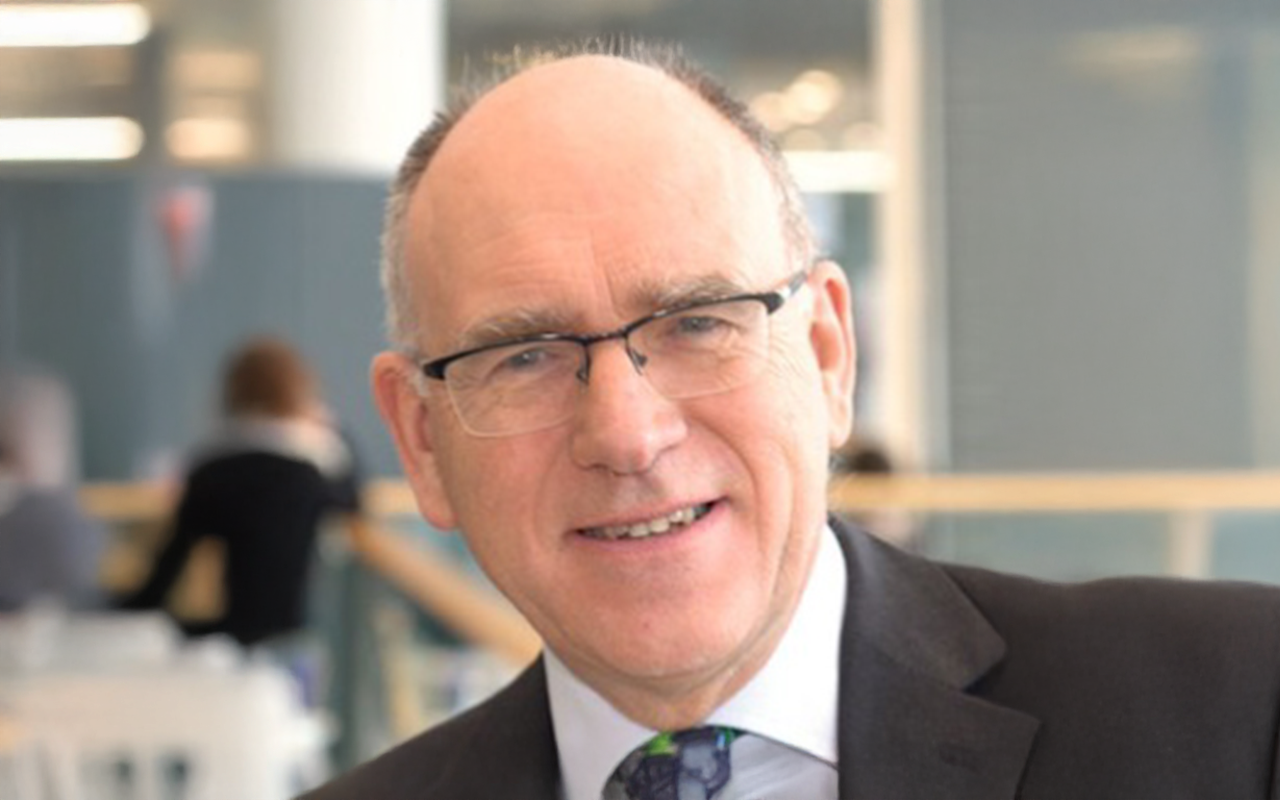Pathways & Perspectives
Before I discovered hematology, I really was on the point of giving medicine up, either to be a lawyer or a crab fisherman. I think I probably would have been a very good crab fisherman. I certainly would have been a useless lawyer and feel very lucky to be where I am at the moment.”
Meet Charles Craddock, CBE, FRCP (UK), FRCPath, DPhil, FMedSci, a professor of hemato-oncology at the University of Birmingham in the United Kingdom.
A leader in transplant and cell therapy, Dr. Craddock has spent a lifetime building global clinical trial networks and advancing blood cancer research. Now, he’s helping launch SOHO UK in 2026—an ambitious new chapter in international collaboration. With characteristic energy, he’s working alongside colleagues to shape a program that reflects the depth and excellence of hemonc in the UK.
What drew you into the field of hematologic oncology?
I was fascinated as a child with being a doctor, having been inspired by my grandfather who worked in a mission hospital in central Africa. However, once I took my medical exams and rotated through the general medical disciplines, I became a little disillusioned because I found that in many of the disciplines such as chest medicine and cardiology—although scientifically fascinating—the interactions with patients were actually often quite brief. It wasn’t until I was at the Hammersmith Hospital in London that I understood that hematology offers the best of both worlds. I was working with John Goldman, who was really a genius hematologist. He was pivotal in developing imatinib. He was the first person in the UK to perform a transplant for leukemia. His example gave me a profound insight into how science can be used to develop transformative new therapies. At the same time, I came to realise that hematology is a very special discipline because it gives you the opportunity to build long-term relationships with patients, which I have found to be one of the most fulfilling aspects of medicine.
Before I discovered hematology, I really was on the point of giving medicine up, either to be a lawyer or a crab fisherman. I think I probably would have been a very good crab fisherman. I certainly would have been a useless lawyer and so feel very lucky to be where I am at the moment.
Can you tell us about your current appointments?
I’ve been in Birmingham since 1999, working in stem cell transplantation. I moved here almost 25 years ago, having trained at the Fred Hutchinson Cancer Center in Seattle and at Oxford and Hammersmith in the UK. I came here because the opportunity arose to build a large transplant program on the basis of quite a small existing unit. I’ve spent my last 20 odd years working happily with colleagues to try to develop transplant and now cell therapy programs. In the last ten years, I’ve been absolutely fascinated by trying to build infrastructures allowing rapid recruitment for patients to clinical trials. We started initially with regional recruitment networks, but more recently we’ve established two national trial acceleration networks: the TAP (Trials Acceleration Program) and more recently, IMPACT—one of only two transplant and cell therapy trial networks in the world.
What are some of the challenges in implementing these multdisciplinary and multi-inter-agency programs?
Most important is putting patients and what they want right at the forefront of everything you’re trying to achieve. The second is teamwork. It’s the team that not only shares the work, but also provides the support, encouragement, and laughter.
I have learnt that the greatest source of inspiration comes from working with patients at the clinical coalface. It’s only by looking after a lot of patients that one starts to understand what are the important clinical questions that are, as of yet, unanswered. In the last ten years, two key questions have emerged. First: what are the most important trials to allow us to rapidly assess the exciting tsunami of new drugs, cellular and transplant therapies? Second: Given the recognition that many critical clinical questions can only be answered through randomized, prospective trials, how do we build networks capable of conducting them? In this context the two national networks we have established, ACT and IMPACT, have been entirely transformational and together have resulted in more than 3,000 patients being randomized into prospective haemato-oncology and transplant trials.
Having identified what some of the important clinical questions are, and then having identified how you might answer them, the question is, how do you raise the money to do this? We’ve had two approaches there. In the first iteration, we were entirely dependent on philanthropic money to fund the TAP and IMPACT networks. We worked with charities across the UK, and persuaded these philanthropic organizations of the impact on patients that delivering high-quality clinical trials can bring. But bang, we were hit by COVID and lost most of our philanthropic funding, simply because during COVID, charities couldn’t get people to run marathons or climb Everest. In response we have established an academically driven social enterprise trial delivery model, ACT—Accelerating Clinical Trials Limited (www.ACT4patients.com. ACT was established as a company limited by guarantee, which in the UK means that whilst it’s commercially nimble it’s more like a Foundation and re-invests any surplus funds it generates back into a clinical trials infrastructure. ACT therefore now funds the TAP and IMPACT networks and—because it is nimble and fast in trial delivery—is proving highly attractive to global pharmaceutical companies for the delivery of both industry sponsored and collaborative academic trials. Critically, ACT is able to generate clinical trial data of the quality required to support registration with a regulatory authority and so delivers a CRO function within the context of an academically directed trial network.
The principle that we will be able to find effective therapies that provide lifelong therapy and outstanding outcomes is now being proven in more and more diseases.
It’s increasingly clear that in 2025 there’s a profound recognition of the importance of trial acceleration networks that are capable of delivering the quality of trial data, particularly pharmacovigilance, that’s required for licensing by the FDA or EMA. There is also a recognition that academic clinical groupings, particularly with a large population base, are able to do this as well as, if not better than, conventional global CROs.
Finally, we must remember that we’re really in a partnership in terms of improving patient outcomes with the global pharmaceutical sector. There are aspects of how global pharma operates that we may not wish to support, but at the core, our goals are aligned: to bring new treatments to patients whose outcomes with standard therapies are poor. I think there is also an increasing recognition that there is real value and impact to patients on delivering registration standard data, which means that you align your ambitions with a number of other partners. Government partners want to see that, but also the pharma partners want to see that. I think that creates a virtuous circle.
What have been some meaningful international collaborations in your career?
One of my greatest pleasures has been building really good relationships with colleagues in the US and Europe. We’ve built strong links with MD Anderson and with many other fantastic colleagues throughout the US. I think particularly of collaborations with Naval Daver at MD Anderson, Gail Roboz in New York, and Steve Devine at CIBMTR. Because they work in the US, they often have access to these new agents quicker than we do, but perhaps our ability in the UK to deliver randomized trials is complementary to some of the groundbreaking work these colleagues do. That’s the first thing: to work as a team internationally and to benefit and learn from brilliant colleagues. The second thing is, I think the US has taught me quite a lot in terms of that clinical trial network approach. Mary Horowitz, who leads the Bone Marrow Transplant Clinical Trials Network, has been absolutely inspirational in helping us to understand that building a trial network across major transplant centers can deliver transformational studies. In terms of the clinical groupings in Europe, I also have been fortunate to have learnt from inspiring clinical triallists like Paresh Vyas, Bob Lowenberg, Hartmut Dohner and Andrew Wei who have been unbelievably generous with their time and taught me the value of academic CRO models such as HOVON and the ALLG. I am convinced that innovative trials delivery models such as these genuinely represent an Amazon moment for haemato-oncology and have the potential to be replicated internationally.
How do you see emerging therapies like gene-based or cellular treatments reshaping the future of leukemia and blood cancer care in general?
We can see it happening. We’ve already seen it with chronic myeloid leukemia (CML). I remember 25, 30 years ago, when I was at the Hammersmith, before the advent of imatinib, that half of our ward was filled with patients with blastic transformation of CML for whom there were no effective treatment options. Today, if you have CML and get promptly treated with a TKI like imatinib, your life expectancy is almost as good as a member of the general population. The principle that we will be able to find effective therapies that provide lifelong therapy and outstanding outcomes is now being proven in more and more diseases. At the same time, you can see that transplant, which was such an important treatment in CML, is no longer required. It’s really only in the acute leukemias, rather than the chronic leukemias, that transplant is still important and the trend whereby cell therapies, and bispecifics, will replace transplant will surely continue. As a result, I am optimistic about the future and believe that in 25 years time, I think it’s reasonable to anticipate that we’ll have effective treatments for everybody with blood cancer. These will increasingly be personalized, and much more gentle on the patient.
Are there any other any new updates that you want to share?
Like the rest of the global hemonc community, we’ve been enormously impressed with the way that the SOHO meeting has developed as a global brand. There’s a freshness about the SOHO meeting, which I think now attracts more than 3,000 attendees, and particularly an emphasis on new ways of learning, new ways of delivering a broad hemonc curriculum, to not only fellows but also to practicing coalface clinicians. We were therefore absolutely delighted when Dr. Kantarjian and colleagues invited the UK to develop its iteration of SOHO meeting, SOHO UK, which is going to launch in March 2026. We’ve had unbelievable interest and support from the UK hemonc community, and working with Tony Goldstone and many of my colleagues, I think we’ve now got a compelling program for 48 hours, which is not only going to cover the length and breadth of hemonc, but it’s going to explore really important new areas such as the role of registries and translational medicine. We want to have it as a party to celebrate the excellence of UK hemonc, and to celebrate our partnership with MD Anderson and other major centers across the world working together to beat cancer to patient benefit.
What do you do in your downtime?
I’ve suddenly discovered a passion for gardening. My dad used to garden, and I thought, how boring. But now we have a fruit cage housing gooseberries and blackcurrants in our little shack in Wales where we now grow unbelievably delicious potatoes and globe artichokes. That’s fun and really interesting; you get an immediate response. I’m also learning to play the piano and am sitting my grade 6 exam, although I still really struggle with Scarlatti’s piano sonatas. Although I can play them, it’s perhaps not in a way that you or Scarlatti would have envisaged. So, it’s the music and the garden that keep me sane.
Enjoyed this Pathways & Perspectives with Charles Craddock? Discover Pia Raanani’s work here.






